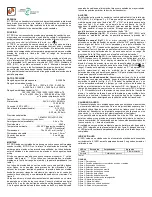
12
CONTACT US TOLL FREE
800-421-6511
www.
picomacom
.com
Fiber Optic
Series
PICO MACOM
5.1 Using the Status Button
The STATUS button controls what is displayed on the front panel LCD. By pressing the STATUS
button repeatedly, you may cycle through pages that display RF input parameters, Power out-
put, Power Supply status and more. Some pages will display only when the LASER ON/OFF
is selected “on”.
5.2 Selecting AGC Mode
For most applications, the desired mode is AGC ON. Variations in RF input level due to drift
and thermal changes in the equipment feeding the signal to the PFT are compensated and the
signal from the other end of the link remains consistent.
To select the AGC ON mode, press the RF AGC ON/OFF button to light the led labeled AGC.
When the input signal is at or near the nominal 15 dBmV levels, the AGC circuitry will inter-
nally adjust to control the 1310nm Optical Transmitter modulation. If the RF LEVEL LED con-
tinues to flash and the front panel displays “Warning…!!! Input RF is too low” or “Warning…!!!
Input RF is too high”, you must either adjust the RF input level at the signal source or use MGC
mode.
5.3 Selecting MGC Mode
To select the MGC ON mode (to turn off AGC mode), press the RF AGC ON/OFF button to
light the led labeled MGC.
Select the MGC mode if:
•
Your application has a desired variation of the input level to be passed onto the
receive end of your link.
•
Your application has an input that is too high level or too low level to allow AGC to
control it.
•
If you have less than 6 channels in your input RF signal. The AGC circuitry may
read the levels of the RF signals in error and overdrive the 1310nm Optical Transmitter
circuitry causing “clipping” distortions that create catastrophic signal impairments.
When you have less than 6 channels (90 MHz of occupied bandwidth) in the lower
part of the 54-860 MHz range, please select MGC mode.
5.4 Adjusting Input Level for Reduced Number of
RF Channels
Laser transmitters are sensitive to both input (peak) level and the total power input Designs are
targeted at typical loading of about 80 channels. There is sufficient “headroom’ is the design
to allow for significant variations in channel count (occupied bandwidth) so as many as 130
channel input are not a problem and do not force a reduction of the input level target from a
nominal 15 dBmV level. (Reducing the level may result in undesirable degradation of C/N.)
If you have significantly less than 80 channels occupied, i.e., below 20 channels or 120 MHz.
of occupied bandwidth, you may wish to increase the input RF level if you source can supply
the higher level to optimizing C/N and other performance factors.




































